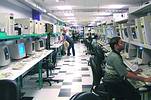
Bulldozers, fried chicken, software and just about everything in between follows the simple rules of supply and demand. You cannot sell what is not wanted and people do not buy what does not satisfy their needs.
At least in the industrial software industry, gone are the days of vendor-driven applications where end-users simply had to make do with the software developer's idea of a good idea. Today, good ideas tend to come from end-users and system integrators to which software developers add their own knowledge of the global needs of the industries they address. This combination of recognising the needs of their clients and addressing them with their own added-value expertise is making Wonderware the industrial solution supplier of choice with an increasing number of manufacturers worldwide. But it does not happen painlessly.

Software is usually remote from the expertise of production managers and CEOs, yet it affects their lives like virtually no other asset. In realtime production environments, the company's bottom line is almost completely in the hands of software that supervises the various aspects of manufacturing execution systems. As such, software developers carry an enormous responsibility - not only for the development of software that is error free but that also provides the necessary functionality and flexibility to provide its end-users with the business advantage they are looking for.
That is why responsible software developers base their products on the needs of their target markets, otherwise they risk losing the millions they invest in its development. A case in point is ArchestrA, Wonderware's industrial application framework. Many hundreds of industry professionals were surveyed before any development started - a good thing too because what these professionals wanted was not yet another application but something that would make disparate applications work in harmony and that would drastically reduce project engineering costs. ArchestrA's functionality is the result of dialogue between its creators and its end-users and that is why it makes so much sense to the industrial automation community.
Sometimes, software is released without user-specified functionality for good reasons. The functionality may make more sense as part of a future release that will incorporate synergistic facilities or it may delay releases because of its complexity or the possibility of introducing errors in existing error-free code that would, in turn, trigger another lengthy cycle of Beta testing (real-life testing of the software by selected clients in running production environments). Another reason for not including requested functionality is that it may only make sense to the person who suggested it but does not apply to the industry as a whole - that is why applications need to be flexible in their ability to be customised to address specific end-user needs. Whatever the reason, it is rarely because the developer simply 'wants to get away with it' - that sort of thinking usually leads to financial suicide in this highly competitive business.
The software development process
Futuristix encourages dialogue between the users of the solutions it offers and their creators because that is always proved to be a win-win situation that the software developer is not likely to discontinue. Suggestions come from end-users and system integrators continuously through various venues such as training courses, the user group, as well as the system integrator and user group conferences that Wonderware and its vendors hold annually. Although the user group represents end-users, the latter are welcome to submit their own feedback as to their individual needs. Differing opinions are also welcome because they ultimately contribute to an improvement for all.
For more information contact Mike le Plastrier, Futuristix Advanced Control Systems, 011 723 9900, [email protected], www.futuristix.co.za
A word about 'undocumented features':
Like manufacturing, software development is an engineering process. Some people are of the belief that adding a couple of lines of code is not exactly as complicated as adding two cylinders to a V6 engine block. While the process may be simpler, the repercussions can be far more dangerous and sometimes, a lot more unpredictable. Object oriented technology (OOT) and structured software development techniques has helped to turn what was previously an art form into an engineering process but they do not cover all the bases. There are as many undocumented features (better known as bugs) in new software as there are in newly modified engine blocks. Engineering helps to handle the known - not the unknown.
© Technews Publishing (Pty) Ltd | All Rights Reserved